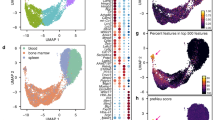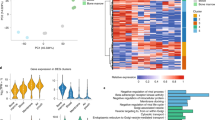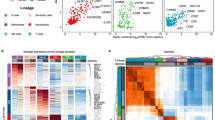Abstract
It has recently been established that neutrophils, the most abundant leukocytes, are capable of changes in gene expression during inflammatory responses. However, changes in the transcriptome as the neutrophil leaves the bone marrow have yet to be described. We hypothesized that neutrophils are transcriptionally active cells that alter their gene expression profiles as they migrate into the vasculature and then into inflamed tissues. Our goal was to provide an overview of how the neutrophil's transcriptome changes as they migrate through different compartments using microarray and bio-informatic approaches. Our study demonstrates that neutrophils are highly plastic cells where normal environmental cues result in a site-specific neutrophil transcriptome. We demonstrate that neutrophil genes undergo one of four distinct expression change patterns as they move from bone marrow through the circulation to sites of inflammation: (i) continuously increasing; (ii) continuously decreasing; (iii) a down-up-down; and (iv) an up-down-up pattern. Additionally, we demonstrate that the neutrophil migration signaling network and the balance between anti-apoptotic and pro-apoptotic signaling are two of the main regulatory mechanisms that change as the neutrophil transits through compartments.
This is a preview of subscription content, access via your institution
Access options
Subscribe to this journal
Receive 12 digital issues and online access to articles
$119.00 per year
only $9.92 per issue
Buy this article
- Purchase on Springer Link
- Instant access to full article PDF
Prices may be subject to local taxes which are calculated during checkout




Similar content being viewed by others
References
Nathan C . Neutrophils and immunity: challenges and opportunities. Nat Rev Immunol 2006; 6: 173–182.
Kobayashi SD, Deleo FR . Role of neutrophils in innate immunity: a systems biology-level approach. Wiley Interdiscip Rev Syst Biol Med 2009; 1: 309–333.
Zhang X, Ding L, and Sandford A.J. Gene expression in mature neutrophils: early responses to inflammatory stimuli. Jo Leuk Biol 2004; 75: 358–372.
Subrahmanyam YV, Newburger PE, Weissman SM . RNA expression patterns change dramatically in human neutrophils exposed to bacteria. Blood 2001; 97: 2457–2468.
Cassatella MA . The production of cytokines by polymorphonuclear neutrophils. Immunol Today 1995; 16: 21–26.
Gosselin E, Wardwell K, Rigby W, Guyre P . Induction of MHC class II on human polymorphonuclear neutrophils by granulocyte/macrophage colony-stimulating factor, IFN-gamma, and IL-3. J Immunol 1993; 151: 1482–1490.
Pelletier M, Maggi L, Micheletti A, Lazzeri E, Tamassia N, Costantini C et al. Evidence for a cross-talk between human neutrophils and Th17 cells. Blood 2010; 115: 335–343.
Shaw JP, Chuang N, Yee H, Shamamian P . Polymorphonuclear neutrophils promote rFGF-2-induced angiogenesis in vivo. J Surg Res 2003; 109: 37–42.
Fridlender ZG, Sun J, Kim S, Kapoor V, Cheng G, Ling L et al. Polarization of tumor-associated neutrophil phenotype by TGF-beta: “N1” versus “N2” TAN. Cancer Cell 2009; 16: 183–194.
Luo HR, Loison F . Constitutive neutrophil apoptosis: mechanisms and regulation. Am J Hematol 2008; 83: 288–295.
Witko-Sarsat VR, Pederzoli-Ribeil M, Hirsh E, Sozzani S, Cassatella MA . Regulating neutrophil apoptosis: new players enter the game. Trends Immunol 2011; 32: 117–124.
Hudock KM, Liu Y, Mei J, Marino RC, Hale JE, Dai N et al. Delayed resolution of lung inflammation in IL- 1RN2/2 mice reflects elevated IL-17A/G-CSF expression. Am J Respir Cell Mol Biol 2012; 47: 436–444.
Gamonal JJ, Sanz M, O'Connor A, Acevedo A, Suarez I, Sanz A et al. Delayed neutrophil apoptosis in chronic periodontitis patients. J Clin Periodontol 2003; 30: 616–623.
Sun CX . Rac1 is the small GTPase responsible for regulating the neutrophil chemotaxis compass. Blood 2004; 104: 3758–3765.
Hasenberg M, Köhler A, Bonifatius S, Borucki K, Riek-Burchardt M, Achilles J et al. Rapid immunomagnetic negative enrichment of neutrophil granulocytes from murine bone marrow for functional studies in vitro and in vivo. PLoS ONE 2011; 6: e17314.
Jiang N . The effect of inflammation on the generation of plasma DNA from dead and dying cells in the peritoneum. J Leuk Biol 2004; 77: 296–302.
Shen H, Kreisel D, Goldstein DR . Processes of sterile inflammation. J Immunol 2013; 191: 2857–2863.
Schroeder A, Mueller O, Stocker S, Salowsky R, Leiber M, Gassmann M et al. The RIN: an RNA integrity number for assigning integrity values to RNA measurements. BMC Mol Biol 2006; 7: 3.
Smyth GK . Linear models and empirical Bayes methods for assessing differential expression in microarray experiments. Stat Appl Genet Mol Biol 2004; 3: 1–26.
Benjamini Y, Hochberg Y . Controlling the false discovery rate: a practical and powerful approach to multiple testing. J R Stat Soc Ser B (Methodol) 1995; 57: 289–300.
Huang DW, Sherman BT, Lempicki RA . Systematic and integrative analysis of large gene lists using DAVID bioinformatics resources. Nat Protoc 2008; 4: 44–57.
Zheng Q, Wang XJ . GOEAST: a web-based software toolkit for Gene Ontology enrichment analysis. Nucleic Acids Res 2008; 36: W358–W363.
Chu VT, Gottardo R, Raftery AE, Bumgarner RE, Yeung K . MeV+R: using MeV as a graphical user interface for Bioconductor applications in microarray analysis. Genome Biol 2008; 9: R118.
Yeung KY, Haynor DR, Ruzzo WL . Validating clustering for gene expression data. Bioinformatics 2001; 17: 309–318.
Wang Y, Lebowitz D, Sun C, Thang H, Grynpas MD, Glogauer M . Identifying the relative contributions of Rac1 and Rac2 to osteoclastogenesis. J Bone Miner Res 2007; 23: 260–270.
Luhtala N . Parker R. LSM1 over-expression in Saccharomyces cerevisiae depletes U6 snRNA levels. Nucleic Acids Res 2009; 37: 5529–5536.
Wang F . The signaling mechanisms underlying cell polarity and chemotaxis. Cold Spring Harbor Perspect Biol 2009; 1: a002980–a002980.
Kumar S, Xu J, Perkins C, Guo F, Snapper S, Finkelman FD, Zheng Y et al. Cdc42 regulates neutrophil migration via crosstalk between WASp, CD11b, and microtubules. Blood 2012; 120: 3563–3574.
Moulding DA, Akgul C, Derouet M, White MR, Edwards SW . BCL-2 family expression in human neutrophils during delayed and accelerated apoptosis. J Leuk Biol 2001; 70: 783–792.
Kirschnek S, Vier J, Gautam S, Frankenberg T, Rangelova S, Eitz-Ferrer P et al. Molecular analysis of neutrophil spontaneous apoptosis reveals a strong role for the pro-apoptotic BH3-only protein Noxa. Cell Death Differ 2011; 18: 1805–1814.
Atallah M, Krispin A, Trahtemberg U, Ben-Hamron S, Grau A, Verbovetski I et al. Constitutive neutrophil apoptosis: regulation by cell concentration via S100 A8/9 and the MEK–ERK pathway. PLoS ONE 2012; 7: e29333.
Kobayashi SD . Spontaneous neutrophil apoptosis and regulation of cell survival by granulocyte macrophage-colony stimulating factor. J Leuk Biol 2005; 78: 1408–1418.
Perretti M . Editorial: To resolve or not to resolve: Annexin A1 pushes resolution on track. J Leuk Biol 2012; 92: 245–247.
Vong L, D'Acquisto F, Pederzoli-Ribeil M, Lavagno L, Flower RJ, Witko-Sarsat V et al. Annexin 1 cleavage in activated neutrophils: a pivotal role for proteinase 3. J Biol Chem 2007; 282: 29998–30004.
Arur S, Uche UE, Rezaul K, Fong M, Scranton V, Cowan AE et al. Annexin I is an endogenous ligand that mediates apoptotic cell engulfment. Dev Cell 2003; 4: 587–598.
Theilgaard-Monch K . The transcriptional program of terminal granulocytic differentiation. Blood 2005; 105: 1785–1796.
Cheretakis C, Leung R, Sun CX, Dror Y, Glogauer M . Timing of neutrophil tissue repopulation predicts restoration of innate immune protection in a murine bone marrow transplantation model. Blood 2006; 108: 2821–2826.
Pillay J, Braber I, Vrisekoop N, Kwast LM, de Boer RJ, Borghans JAM et al. In vivo labeling with 2H2O reveals a human neutrophil lifespan of 5.4 days. Blood 2010; 116: 625–627.
Kobayashi SD, Braughton KR, Whitney AR, Voyich JM, Schwan TG, Musser JM et al. Bacterial pathogens modulate an apoptosis differentiation program in human neutrophils. Proc Natl Acad Sci USA 2003; 100: 10948–10953.
Coldren CD, Nick JA, Poch KR, Wollum MD, Fouty BW, O'Brien JM et al. Functional and genomic changes induced by alveolar transmigration in human neutrophils. Am J Physiol Lung Cell Mol Physiol 2006; 291: L1267–L1276.
Kotz KT, Xiao W, Miller-Graziano C, Qian WJ, Russom A, Warner EA et al. Clinical microfluidics for neutrophil genomics and proteomics. Nat Med 2010; 16: 1038–1043.
Pelletier M, Micheletti A, Cassatella MA . Modulation of human neutrophil survival and antigen expression by activated CD4+ and CD8+ T cells. J Leuk Biol 2010; 88: 1163–1170.
Davey MS, Tomassia N, Rossato M, Bazzoni F, Calzetti F, Bruderek K et al. Failure to detect production of IL-10 by activated human neutrophils. Nat Immunol 2011; 12: 1017–1018.
Zhang X, Ding L, Sandford AJ . Selection of reference genes for gene expression studies in human neutrophils by real-time PCR. BMC Mol Biol 2005; 6: 4.
Hu Y . Isolation of human and mouse neutrophils ex vivo and in vitro. Leuc Methods Protoc 2011; 844: 101–113.
Siemsen DW, Quinn M . Neutrophil isolation from nonhuman species. Methods Mol Biol 2007; 412: 21–34.
de Santo C, Arscott R, Booth S, Karydis I, Jones M, Asher R et al. Invariant NKT cells modulate the suppressive activity of IL-10-secreting neutrophils differentiated with serum amyloid A. Nat Immunol 2010; 11: 1039–1046.
Kumar S, Xu J, Perkins C, Guo F, Snapper S, Finkelman FD, Zheng Y et al. Cdc42 regulates neutrophil migration via crosstalk between WASp, CD11b, and microtubules. Blood 2012; 120: 3563–3574.
Fridlender ZG, Sun J, Mishalian I, Singhal S, Cheng G, Kapoor V et al. Transcriptomic Analysis Comparing Tumor-Associated Neutrophils with Granulocytic Myeloid-Derived Suppressor Cells and Normal Neutrophils. PLoS ONE 2012; 7( 2): e31524. doi:10.1371/journal.pone.0031524
Servant G, Weiner OD, Neptune ER, Sedat JW, Bourne HR . Dynamics of a chemoattractant receptor in living neutrophils during chemotaxis. Mol Biol Cell 1999; 10: 1163–1178.
Zhelev DV, Alteraifi AM, Chodniewicz D . Controlled pseudopod extension of human neutrophils stimulated with different chemoattractants. Biophys J 2004; 87: 688–695.
Wong CH, Heit B, Kubes P . Molecular regulators of leucocyte chemotaxis during inflammation. Cardiovasc Res 2010; 86: 183–191.
Sun R, Iribarren P, Zhang N, Zhou Y, Gong W, Cho EH et al. Identification of neutrophil granule protein cathepsin G as a novel chemotactic agonist for the G protein-coupled formyl peptide receptor. J Immunol 2004; 173: 428–436.
Ye RD, Boulay F, Wang JM, Dahlgren C, Gerard C, Parmentier M et al. International union of basic and clinical pharmacology. LXXIII. Nomenclature for the formyl peptide receptor (FPR) family. Pharmacol Rev 2009; 61: 119–161.
Suraneni P, Rubinstein B, Unruh JR, Durnin M, Hanein D, Li R . The Arp2/3 complex is required for lamellipodia extension and directional fibroblast cell migration. J Cell Biol 2012; 197: 239–251.
Maianski NA, Maianski AN, Kuijpers TW, Roos D . Apoptosis of neutrophils. Acta Haematol 2004; 111: 56–66.
Hannon R . Aberrant inflammation and resistance to glucocorticoids in Annexin 1−/− mouse. FASEB J 2003; 17: 253–255.
Lakschevitz FS, Aboodi GM, Glogauer M . Oral neutrophil transcriptome changes result in a pro-survival phenotype in periodontal diseases. PLoS ONE 2013; 8: e68983.
Lakschevitz FS, Aboodi GM, Glogauer M . Oral neutrophils display a site-specific phenotype characterized by expression of T-cell receptors. J Periodontol 2012; 84: 1493–1503.
Puellmann K, Kaminski WE, Vogel M, Nebe CT, Schroeder J, Wolf H et al. A variable immunoreceptor in a subpopulation of human neutrophils. Proc Natl Acad Sci USA 2006; 103: 14441–14446.
de Kleijn S, Langereis JD, Leentjens J, Kox M, Netea MG, Koenderman L et al. IFN-γ-stimulated neutrophils suppress lymphocyte proliferation through expression of PD-L1. PLoS ONE 2013; 8: e72249.
Acknowledgements
This work was funded by an operating grant from The Canadian Institutes of Health Research (CIHR, Ottawa, ON, Canada) to MG. FL is supported by CIHR Training Fellowship, TGF-53877 and the Harron scholarship (Faculty of Dentistry, University of Toronto). The authors give special thanks to Dionne White from The Flow Cytometric Facility of the Immunology Department, Faculty of Medicine of University of Toronto for assistance with flow cytometric analysis, also to Guillermo Casallo and Pingzhao Hu of the Centre for Applied Genomics, The Hospital for Sick Children, Toronto, Canada, for assistance with microarray analysis and statistical analysis respectively.
Author information
Authors and Affiliations
Corresponding author
Ethics declarations
Competing interests
The authors declare no competing financial interests.
Additional information
Supplementary Information accompanies the paper on Cellular & Molecular Immunology's website. (http://www.nature.com/cmi).
Supplementary information
Rights and permissions
About this article
Cite this article
Lakschevitz, F., Visser, M., Sun, C. et al. Neutrophil transcriptional profile changes during transit from bone marrow to sites of inflammation. Cell Mol Immunol 12, 53–65 (2015). https://doi.org/10.1038/cmi.2014.37
Received:
Revised:
Accepted:
Published:
Issue Date:
DOI: https://doi.org/10.1038/cmi.2014.37
Keywords
This article is cited by
-
Neutrophils in cancer: heterogeneous and multifaceted
Nature Reviews Immunology (2022)
-
Locally organised and activated Fth1hi neutrophils aggravate inflammation of acute lung injury in an IL-10-dependent manner
Nature Communications (2022)
-
Characterization and allergic role of IL-33-induced neutrophil polarization
Cellular & Molecular Immunology (2018)
-
Cellular and molecular regulation of innate inflammatory responses
Cellular & Molecular Immunology (2016)
-
Oral polymorphonuclear neutrophil characteristics in relation to oral health: a cross-sectional, observational clinical study
International Journal of Oral Science (2016)



